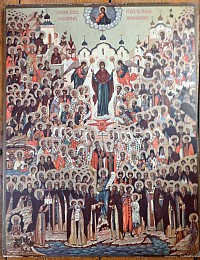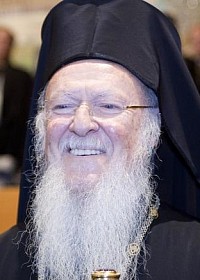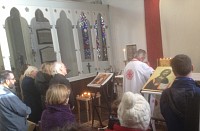History of the Orthodox Church
At the beginning of the first century, Jesus Christ was born, ministered, died and was resurrected. In the years that followed, the Apostles spread Christ's teachings, proclaimed the good news of his saving sacrifice and resurrection, and founded many churches, united in faith. These churches included several that were later to become centres of ecclesiatical jurisdiction (patriarchates). The church of Alexandria was founded by St. Mark, the church at Antioch by St Paul, the church at Jerusalem by Saints Peter and James, the church at Rome by Saints Peter and Paul, and the church at Constantinople by St Andrew.
Each of these independent churches developed in union with the others, and when major issues arose that could not be dealt with informally, church councils were convened. Seven of these - the first occurring in 325 A.D., the last in 787 A.D. - were accepted as "ecumenical councils" whose decisions were regarded as binding on all. Missionaries spread this faith, and those from Constantinople converted the Slavs and other peoples of Eastern Europe to Christianity (Bulgaria, 864; Russia, 988) translating Scripture and liturgical texts into the vernacular languages used in the various regions. The Orthodox church, therefore, is Pre-Denominational, being the tradition closest to the worship of the Early Church, and which existed before other denominations formed.
However, problems arose, not least because the Pope of Rome - regarded by the other patriarchs as "first among equals" - made claims to jurisdiction over them that the other patriarchs regarded as going far beyond his legitimate role in safeguarding the unity of the church. Long-standing tensions came to a head in A.D.1054, in which year - from the Orthodox perspective - the Christians of the West, under the Pope of Rome, separated themselves from the universal church. It was thought at the time that this constituted only a temporary breach in communion between the "Roman Catholics" of the West and the "Orthodox" of the East, but sadly this breach still exists today, exacerbated by what the Orthodox regard as improper additions by the Romans to the faith of the ancient, undivided church.
This problem of disunity was further exacerbated when some Western Christians, in the reformation of the sixteenth century, separated themselves from Rome. From the Orthodox perspective, these "protestants" set up a diminished faith, in which much that constitutes the fullness of Christian belief and practice was denied. Thus, from the Orthodox perspective, Western Christianity is not only divided, but fails in any of its ecclesial forms to manifest to the world the faith of the ancient, undivided church. The "Eastern" churches, by contrast, remain united in faith, strongly committed to the Tradition of the early centuries, and together they constitute what is called the “Orthodox Church”, the word Orthodox literally meaning "right glory" - both in the sense of "right belief" and "right worship". The beliefs and practices of Orthodox Christians today are essentially those of all Christians before the great division of nearly a thousand years ago.
Fortunately, we do not have to travel to the East nowadays to experience Orthodoxy. Emigrants from Eastern countries - especially Russians after the 1917 revolution - came to live in Western Europe and set up Orthodox parishes. In time, at least some of these parishes effectively ceased to be "Russian" or "Greek", in the ethnic sense, because more and more "native" converts were made and second and third-generation immigrants could only speak the language of the country in which they live. Thus, while some Orthodox parishes may still seem "foreign" to the natives of Western Europe, others, like ours, are determined to live and worship in a way that is not only true to Orthodoxy but also appropriate to our local situation. We work with a vision of the day when a truly "local" Orthodox Church will exist once again in these islands. (An organisation calling itself the "British Orthodox Church" does exist but it is not recognised by any other Orthodox body and cannot be regarded as part of the true Orthodox Church. Only through a slow evolution can a truly local church with its own characteristics eventually achieve the degree of maturity necessary for self-governing status.)
We local Orthodox do not, then, regard ourselves as a foreign import, but rather as the continuation of the ancient, undivided church that existed in these islands from a very early period. For this reason, Western saints from before the mid-eleventh century - Augustine of Canterbury, David of Wales, Patrick of Ireland, Columba of Iona and many others - are regarded by us as Orthodox saints, just as much as are the saints of the countries in which Orthodoxy has an uninterrupted history. Several ikons of these early British and Irish saints are to found on the walls of our church (The gallery is here).
The inspiration for establishing an Orthodox presence in Walsingham coincided with the start of the building in of the Anglican Shrine in 1931. The vicar of the local Anglican parish, Father Hope Patten, invited the Orthodox to take part in the venture. Eventually, a small Orthodox Chapel was included within the enlarged Shrine Church, upstairs on the south side of the High Altar.
During the Second World War a prisoner-of-war camp in the locality contained a number of captured Eastern Europeans, many of whom were Orthodox and used the chapel. However, after the War, the congregation - now ex-prisoners and displaced persons - gradually left the area and regular services ceased. For the following decade there was no resident priest, but a number of Orthodox pilgrimages were held.
In 1966, the Administrator of the Anglican Shrine asked the Orthodox to take responsibility for the care of the Chapel, and a missionary Brotherhood of St Seraphim was formed to establish a permanent Orthodox presence in Walsingham. Its task was to include Iconography, the printing of English texts of the Orthodox services, missionary activity and work with the poor and homeless. The disused railway station in Little Walsingham proved to be the only property that the Brotherhood could afford to rent. Led by Father Mark Meyrick (later to become Father David) they converted the ex-booking hall and ticket-office into their Church which, in August 1967, was blessed by Bishop Nikodem of the Russian Orthodox Church in Exile, and dedicated to St Seraphim.
Early in 1978 the exclusive claims of the Russian Orthodox Church in Exile became too restrictive for Father Mark and the Brotherhood. They asked Metropolitan Anthony of Sourozh to receive them under his jurisdiction within the Moscow patriarchate. He served the Liturgy in St Seraphim's and in the Shrine in September of that year, and in 1980 made Father Mark a monk and gave him the name of David. Then, in 1982 on a second visit, Metropolitan Anthony made Hieromonk David Hegumen of the monastery, and five years later Archimandrite. (A Hieromonk is a monk who has been ordained priest, or a priest who has become a monk. A Hegumen is the person in charge of a monastery. An Archimandrite ranks higher than a Hegumen but the duties are the same).
The future of the St. Seraphim's church building was, however, uncertain, since it was only rented. (Only much later was it bought, to be run by a Trust which is quite separate from the parish, though under the same jurisdiction). In 1986, by means of a loan, the former Methodist Chapel in Great Walsingham was purchased, an appeal was launched, and work began at once to convert the chapel for use as an Orthodox Church. In August of that year Metropolitan Anthony visited Walsingham and gave his blessing for the formation of an Orthodox Parish with its centre of worship in the converted chapel. Father David's splendid icons, together with the designs of a well-known Anglican church architect (later a convert to Orthodoxy) transformed the building. By the Summer of 1988, the alterations were complete (apart from a few extra ikons added later by Father David's pupil, Leon Liddament). The Church of the Holy Transfiguration was consecrated by Metropolitan Anthony on October 1st of that year and, at the same service, Deacon Philip Steer, who had for some years been the Choir Leader at St Seraphim's, was ordained Priest to serve in the Parish.
After Fr. Philip's resignation, due to ill-health, Deacon Patrick Radley was ordained Priest. During his incumbency, problems arose within the Sourozh diocese, especially after the death of Metropolitan Anthony. Fr.Patrick, having been canonically released from his position in the Sourozh diocese, agreed with the parishioners that the parish should (with many other parishes around the country) follow the lead of the diocesan administrator, Bishop Basil of Sergievo, and ask to be taken into the jurisdiction of the Ecumenical Patriarch in Constantinople. The Patriarch agreed, and the parish became part of the Exarchate of parishes of Russian tradition in Western Europe, under the immediate jurisdiction of the Archbishop of Comana.
After Fr. Patrick's death, the parish was led by the priest of the Norwich parish, Fr.Patrick Hodson, until Fr.Christopher Knight, after a year serving as a deacon, was able to be ordained as priest and become the Rector of the parish in 2009. In 2012, an assistant priest, Fr. David Davis, was also ordained.
The historical line from St Andrew to the current Ecumenical Patriarch
Ecumenical Patriarch Bartholomew
In 381, the First Council of Constantinople declared that "The Bishop of Constantinople shall have the primacy of honour after the Bishop of Rome, because it is New Rome" (canon iii). The Patriarchs refused to confirm this canon. Nonetheless, the prestige of the office continued to grow not only because of the obvious patronage of the Byzantine Emperor but because of its overwhelming physical and geographical importance. In practice, the Bishop of Rome eventually acknowledged this situation. The Council of Chalcedon in 451 established Constantinople as a patriarchate with ecclesiastical jurisdiction over Asia Minor (the dioceses of Asiane and Pontus) and Thraceas well as over the barbaric territories, non-converted lands outside the defined area of the Western Patriarchate (Old Rome) and the other three patriarchates, Alexandria, Antioch and Jerusalem, gave it appellate jurisdiction extraterritorially over canon law decisions by the other patriarchs and granted it honours equal to those belonging to the first Christian see, Rome, in terms of primacy, Rome retaining however its seniority (canon xxviii). Leo I refused to accept this canon, basing himself on the fact that it was made in the absence of his legates. In the 6th century, the official title became that of "Archbishop of Constantinople, New Rome, and Ecumenical Patriarch." The idealistic vision of a Pentarchy to govern the whole Christian world was espoused and advocated for by Justinian, the Patriarchate of Constantinople was the The Ecumenical Patriarch has no direct jurisdiction outside the Patriarchate of Constantinople granted to him in Orthodox canonical literature, but his primary function regarding the whole Orthodox Church is one of dealing with relations between autocephalous and autonomous churches. That is, his primary role is one of promoting and sustaining Church unity. This unique role often sees the Ecumenical Patriarch referred to as the "spiritual leader" of the Orthodox Church in some sources, though this is not an official title of the patriarch nor is it usually used in scholarly sources on the patriarchate. Such a title is acceptable if it refers to this unique role, but it sometimes leads to the mistaken belief that the office is thus the equivalent of an Orthodox papacy. There is, however, no Orthodox notion equivalent to the papacy: the Orthodox churches operate in the synodical system, whereby ecclesiastical matters are settled by the competent synod of bishops, in which each bishop has one vote. The five patriarchs of the ancient Pentarchy (Rome, Constantinople, Alexandria, Antioch, and Jerusalem, in that order) are to be given seniority of honour, but have no actual power over other bishops other than the power of the synod they are chairing (and in which they also wield one vote). In 2007, the Patriarch gave his approval to the Declaration of Ravenna, a Catholic–Orthodox document re-asserting that the Bishop of Rome is indeed the Prōtos ("First") of the Church, as in "first among equals" and not supreme, although future discussions are to be held on the concrete ecclesiological exercise of papal primacy. According to "Subsistit in" in Lumen Gentium, the Patriarch is a validly consecrated bishop in Roman ecclesiology, and there is merely an imperfect ecclesial communion between Constantinople and Rome, which exists nevertheless and which may be improved at some point in history. A direct result of this ideal in the Byzantine Empire.
Bartholomew I (Greek: Πατριάρχης Βαρθολομαῖος Α', Patriarchis Bartholomaios A' , Turkish: Patrik I. Bartholomeos; born 29 February 1940) is the 270th and current Archbishop of Constantinople and Ecumenical Patriarch, since 2 November 1991. In the Eastern Orthodox Church, he is regarded as the primus inter pares(first among equals), and as the spiritual leader of the world's 300 million Orthodox Christians.
Born Dimitrios Arhondonis (Greek: Δημήτριος Αρχοντώνης, Dimítrios Archontónis), in the village of Agios Theodoros on the island of Imbros (later renamed Gökçeada by Turkey), after his graduation he held a position at the Patriarchal Theological Seminary of Halki, where he was ordained a priest. Later, he served as Metropolitan of Philadelphia and Chalcedon and he became a member of the Holy Synod as well as other committees, prior to his enthronement as Ecumenical Patriarch.
Bartholomew's tenure has been characterized by intra-Orthodox cooperation, inter-Christian and inter-religious dialogue, as well as by formal visits to Catholic, Orthodox and Muslim leaders seldom previously visited by an Ecumenical Patriarch. He has exchanged numerous invitations of Church and State dignitaries. His efforts to promote religious freedom and human rights, his initiatives to advance religious tolerance among the world’s religions, as well as his efforts to promote ecology and the protection of the environment, have been widely noted, and these endeavors have earned him the title "The Green Patriarch". Among his many international positions, he currently sits on the Board of World Religious Leaders for the Elijah Interfaith Institute.
The Ecumenical Patriarch delegates responsibility for us to an archbishop, and subsequently we are under the jurisdiction of The Greek Metropolitan, Nikitas of Thyatiera
The Orthodox presence in King's Lynn




